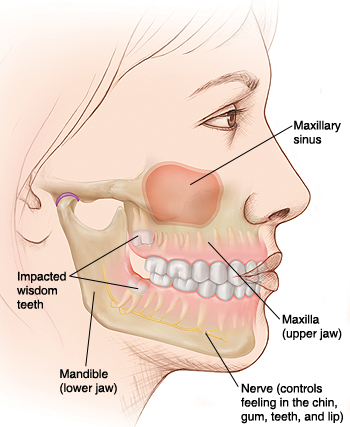Understanding Wisdom Teeth
Understanding Wisdom Teeth
Wisdom teeth are very much like your other permanent teeth. The main difference is that they are the last to develop and grow in (when you’re “older and wiser”). Most people have 4 wisdom teeth, 1 in each corner of the mouth. Some people naturally lack 1 or more of their wisdom teeth.

Wisdom teeth and your dental anatomy
There are several types of teeth. Each type is designed either for biting or for chewing. The wisdom teeth are molars, or chewing teeth. Both the upper and lower jaws have 3 molars on each side. The wisdom teeth are the last in line, which is why they’re called third molars. Because there are 8 other molars to do the chewing, most people can get along fine without wisdom teeth.
Anatomy of a tooth
The crown of a molar is the part of the tooth that is covered with enamel and has a hard chewing surface. Below the gumline, the root anchors the tooth to the bone. Nerves and blood vessels enter and exit the tooth through the roots.
How wisdom teeth develop
All teeth form within the jawbones. As the roots grow, the tooth’s crown gradually pushes toward the gum until it breaks through the gum (erupts). After a tooth has erupted, the roots continue to lengthen. It takes years for the roots to develop completely. The jawbones become denser and more rigid over time.
Around age 9, wisdom teeth start to form inside the jawbones. The jawbones have a lot more growing to do, so they are not yet at their full density.
By the late teens, wisdom teeth roots have developed and are lengthening. The crown of each wisdom tooth may begin to erupt.
By the early 20s, each wisdom tooth has erupted or is unable to fully erupt (impacted). The roots may still be forming. The jawbones have finished growing.
By about age 40, the roots of the wisdom teeth are solidly anchored in the bone. The jawbones have reached their adult density.
Updated:
October 10, 2017
Sources:
Dental Growth and Development, American Academy of Pediatric Dentistry
Reviewed By:
Finke, Amy, RN, BSN,Kapner, Michael, DDS